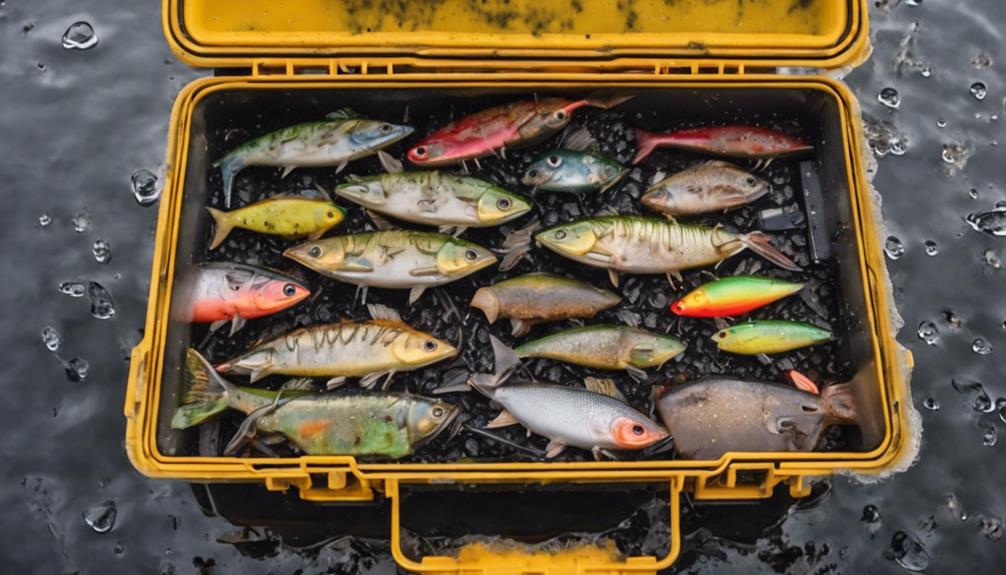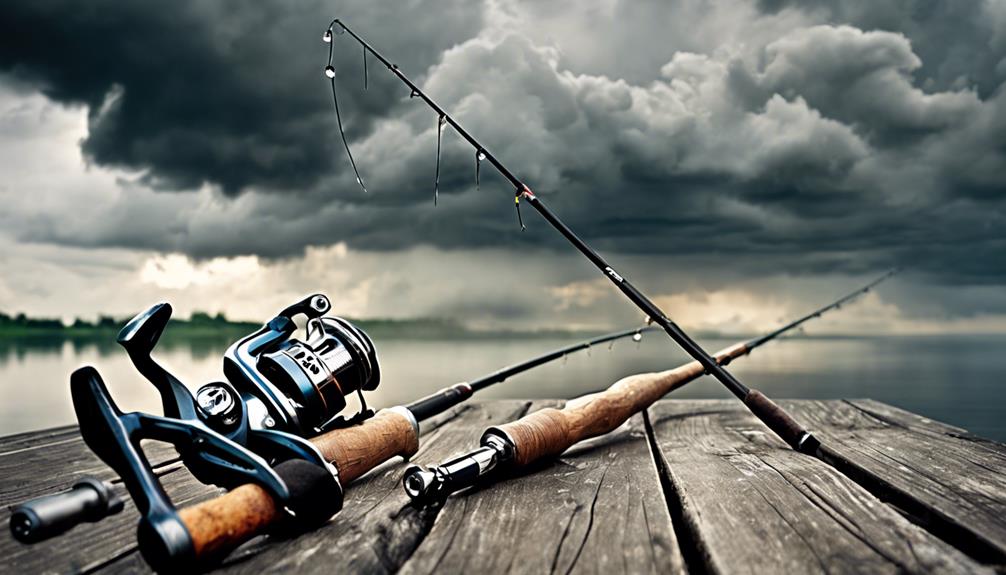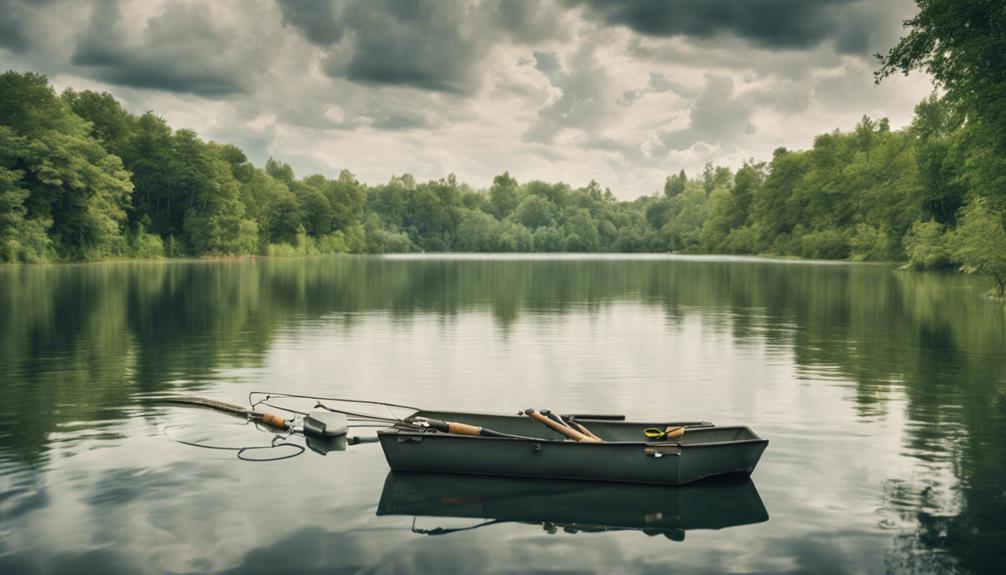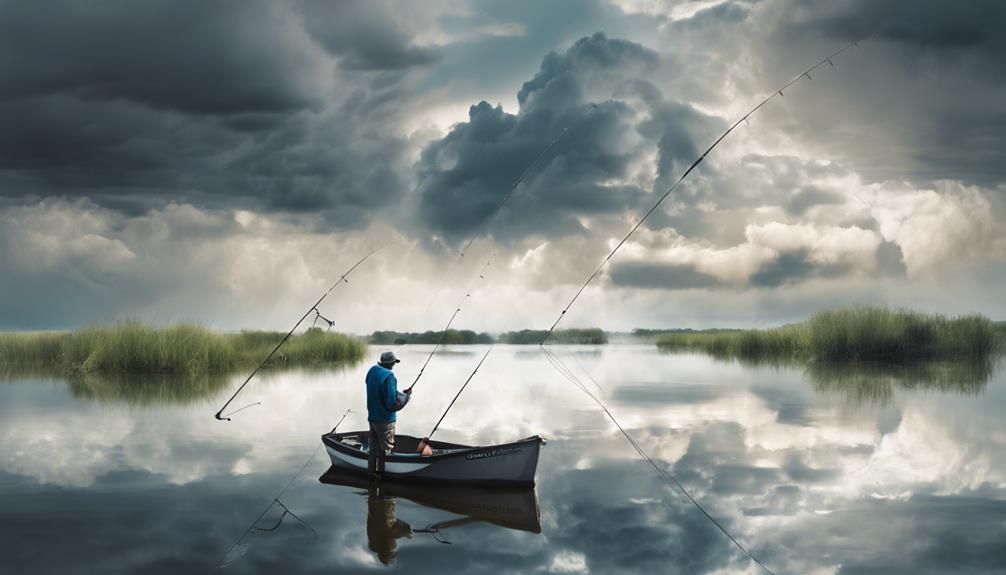Weather significantly impacts your fishing gear. Wind affects casting precision and boat stability. Temperature variations influence rod flexibility. Proper gear selection based on weather conditions is crucial. Match lures to prevailing weather for optimal effectiveness. Consider reel types and line capacity based on weather patterns. Tackle maintenance prevents corrosion. Waterproof materials protect gear against elements. Clothing with breathable and waterproof features is essential. Sealed seams in waterproof gear offer added protection. Ensuring gear suits weather conditions enhances fishing success. Understanding these factors helps you make the most of your fishing trips.
Importance of Weather Conditions
Understanding the importance of weather conditions is crucial for optimizing your fishing gear and increasing your chances of a successful catch. Weather patterns play a significant role in determining your fishing success. Different weather conditions can impact fish behavior, affecting their feeding patterns and movements. By being aware of weather forecasts and patterns, you can adjust your fishing techniques and gear accordingly to maximize your chances of a good catch.
Temperature variations are particularly important to consider when evaluating your equipment performance. For example, in colder temperatures, fish tend to move slower, requiring you to adjust the retrieval speed of your lures or baits. Additionally, extreme heat can affect the oxygen levels in the water, influencing where fish are located. This knowledge can help you select the right bait and fishing depth to target the fish more effectively.
Furthermore, weather conditions such as wind strength and direction can impact your fishing experience. Strong winds can make casting more challenging and affect the stability of your boat. Understanding how wind patterns behave in different weather scenarios can assist you in positioning yourself strategically to improve your fishing efficiency.
Impact on Fishing Rods
When considering the impact of weather conditions on your fishing gear, one crucial element to focus on is how different weather patterns can affect the performance and durability of your fishing rods. Rod sensitivity plays a significant role in determining how well you can detect bites and adjust your fishing technique accordingly. In cold weather, the sensitivity of your rod may decrease due to the stiffness of the rod material, making it harder to feel subtle movements underwater. On the other hand, in hot weather, some rods may become overly sensitive, resulting in false alarms from environmental factors like wind or currents.
Flexibility needs also vary depending on the weather conditions you're fishing in. In colder temperatures, rods tend to become more brittle and may be prone to breaking if they aren't designed to withstand such conditions. It's crucial to choose a rod with the right balance of flexibility and strength to prevent breakage. Conversely, in hot weather, the flexibility of your rod may increase, affecting your casting accuracy and overall control of the line.
Therefore, when selecting a fishing rod, consider the rod sensitivity and flexibility needs that align with the weather conditions you're likely to encounter. This will ensure that your fishing rod performs optimally, enhancing your overall fishing experience.
Influence on Fishing Line
Your fishing line's performance is significantly influenced by weather conditions, impacting its strength and durability. The type of fishing line you use plays a crucial role in determining how it will react to different weather elements. Monofilament lines are prone to weakening when exposed to sunlight for extended periods. High temperatures can cause the line to become brittle and lose its strength, increasing the likelihood of breakage when fighting a fish. On the other hand, fluorocarbon lines are more resistant to UV rays and maintain their strength better in hot weather conditions.
Moreover, humidity levels can affect the durability of your fishing line. Moisture absorption can weaken certain types of lines, such as braided lines, making them more prone to breakage. It's essential to store your fishing lines properly in a dry place to prevent them from absorbing moisture from the air.
When it comes to knot tying techniques, weather conditions can also play a role. Wet weather can make it challenging to tie secure knots, as moisture can weaken the line and cause it to slip. In rainy conditions, consider using knot-tying tools or carrying a small towel to keep your hands dry while tying knots to ensure they're strong and reliable. Mastering different knot tying techniques can help compensate for the impact of weather on your fishing line's performance.
Effects on Lures and Baits
The performance of lures and baits in fishing can be significantly influenced by various weather conditions, impacting their effectiveness in attracting fish. When considering fishing techniques, it's essential to match the lure selection with the prevailing weather conditions for optimal results. Different weather patterns can affect the behavior of fish, thus requiring adjustments in the types of lures and baits used.
Water temperature plays a crucial role in determining bait effectiveness. In warmer waters, fish tend to be more active, making fast-moving lures like crankbaits and spinners more effective. Conversely, in colder waters, fish are usually more sluggish, requiring slower presentations such as jigs or soft plastics. Understanding how water temperature influences fish behavior can help you select the right lures and baits to entice bites.
Additionally, weather conditions like wind and sunlight can impact the visibility of lures and baits in the water. On windy days, using lures with bright colors or noisy features can help fish locate them amidst choppy waters. In contrast, on calm, sunny days, more natural-colored lures that mimic local baitfish may yield better results.
Considerations for Reels
Consider the reel's gear ratio when selecting fishing gear to ensure optimal performance based on the target fish species and desired retrieval speed. The gear ratio indicates how many times the spool rotates with one turn of the handle. For example, a 7.1:1 gear ratio means the spool rotates 7.1 times with each full handle turn. Higher gear ratios like 7.1:1 are great for fast retrieval, ideal for techniques like flipping or pitching where quick line pickup is crucial. On the other hand, lower gear ratios such as 5.1:1 provide more torque, suitable for techniques like deep cranking or when fighting large fish.
Gear Maintenance: Regularly clean and lubricate your reels to prevent corrosion and ensure smooth operation. Saltwater fishing can be particularly harsh on reels, so rinse them with freshwater after each use and apply reel oil to key areas to prolong their lifespan.
Reel Types: Consider the different types of reels available, such as baitcasting, spinning, or spincast reels. Each type has its advantages and is suited for different fishing techniques and conditions. Baitcasting reels offer more control and power, while spinning reels are easier to use and are more versatile for various fishing styles.
Line Capacity: Choose a reel with an appropriate line capacity for the type of fishing you'll be doing. A larger line capacity is essential for targeting bigger fish or when using heavier lines, whereas a smaller capacity is suitable for finesse fishing or targeting smaller species.
Weather's Role in Clothing
Incorporate weather considerations into your clothing choices to optimize comfort and performance during your fishing expeditions. When it comes to fishing attire, layering strategies are essential for adapting to changing weather conditions.
Start with a moisture-wicking base layer to keep sweat away from your skin. This helps regulate your body temperature and prevents chafing. For the middle layer, choose insulating materials like fleece or wool to trap heat while allowing moisture to escape. Finally, the outer layer should be made of waterproof materials to shield you from rain and wind.
Selecting the right waterproof materials is crucial for staying dry and comfortable. Look for clothing items made from materials like Gore-Tex or nylon with durable water repellent (DWR) finishes. These fabrics provide excellent protection against the elements while remaining breathable to prevent overheating. A waterproof jacket with sealed seams and adjustable cuffs will keep water out even in heavy rain.
Remember to also consider waterproof pants or bibs to complete your ensemble. Opt for pieces with reinforced knees and seat areas for durability during long hours by the water. Additionally, waterproof gloves and hats can help you stay dry and maintain dexterity in wet conditions.
Impact on Tackle Boxes

Adapting your tackle box to varying weather conditions is key for optimizing your fishing experience and success. Weather can have a significant impact on your tackle organization, gear protection, maintenance, and selection.
- Tackle Organization: In humid conditions, moisture can lead to rust on metal hooks and other tackle. To prevent this, consider using rust-resistant tackle storage options like plastic tackle trays or boxes with anti-corrosion properties. Additionally, organize your tackle by type and size to easily locate what you need in changing weather conditions.
- Gear Protection: Extreme temperatures, whether hot or cold, can damage certain types of fishing gear. To protect your equipment, invest in a quality tackle box that offers insulation to regulate internal temperatures. For hot weather, consider a box with UV protection to prevent damage from sun exposure. In cold weather, insulated boxes can prevent your lines from freezing.
- Tackle Maintenance and Selection: Weather changes can affect fish behavior, requiring adjustments in your tackle selection. Keep your hooks sharpened and lines properly spooled to ensure optimal performance. In rainy conditions, pack extra waterproof tackle bags to protect your gear. Choose lures and baits that are suitable for the current weather and water conditions to increase your chances of a successful fishing trip.
Weatherproofing Your Gear
To weatherproof your fishing gear effectively, prioritize selecting materials and storage options that offer protection against the elements. Gear maintenance is crucial to ensure your equipment remains in top condition. Begin by choosing gear made from waterproof materials such as PVC or nylon. These materials provide a protective barrier against moisture, preventing rust and corrosion on metal components. Additionally, consider investing in gear with sealed seams and water-resistant zippers to further enhance its waterproof capabilities.
Incorporating waterproofing techniques can significantly extend the lifespan of your gear. Apply a waterproofing spray to items like backpacks, tackle bags, and clothing to create a water-repellent layer. This simple yet effective method can prevent water from seeping into your gear during rainy or wet conditions. For reels and other mechanical components, regularly lubricate them with a waterproof grease or oil to maintain smooth operation and prevent water damage.
When it comes to storage, opt for waterproof tackle boxes or bags to protect your lures, hooks, and other small items. Storing your gear in a dry, ventilated area when not in use can also help prevent mold and mildew growth. By implementing these gear maintenance practices and waterproofing techniques, you can ensure that your fishing equipment remains in optimal condition and ready for your next angling adventure.
Frequently Asked Questions
Can Extreme Weather Conditions Damage Fishing Electronics?
Extreme weather conditions can indeed damage fishing electronics if not properly protected. To prevent this, it's crucial to utilize weatherproofing techniques.
Ensure that your electronics are adequately shielded from moisture, temperature fluctuations, and other environmental factors.
Proper electronics protection, such as using waterproof cases or covers, can significantly extend the lifespan of your equipment and keep it functioning optimally in harsh weather conditions.
How Does Weather Affect the Buoyancy of Fishing Lures?
When temperature changes, it can impact the buoyancy of fishing lures. Warmer water can cause lures to sink faster, while colder water may make them float higher.
Wind speed can also affect lure performance by altering their movement in the water.
Understanding how these weather factors influence buoyancy and lure behavior can help you choose the right gear for optimal fishing success.
Does the Weather Impact the Durability of Fishing Hooks?
In fishing, the weather can indeed impact the durability of fishing hooks. Various weather conditions can affect the rust resistance of hooks, leading to corrosion and reduced hook longevity.
To prevent rust and ensure the longevity of your hooks, it's advisable to use corrosion-resistant materials and regularly maintain your gear. By keeping your hooks in good condition, you can improve their performance and increase your chances of a successful catch.
What Role Does Weather Play in Selecting Sinkers and Floats?
When choosing sinkers and floats, weather conditions critically influence tackle selection.
The weather determines the ideal weight and type of sinker needed to maintain proper bait presentation. In windy conditions, heavier sinkers are necessary to prevent your line from drifting.
Floats must also be adjusted based on weather factors like wind speed and water currents to ensure proper visibility and sensitivity when detecting bites.
Adapting your fishing techniques to the weather enhances your chances of a successful catch.
Are There Specific Weather-Related Maintenance Tips for Fishing Reels?
To maintain your fishing reels in top condition, focus on reel lubrication and corrosion prevention. Regularly oiling moving parts keeps them running smoothly.
When not in use, store your reels properly in reel covers to shield them from moisture and dust.
These simple steps can extend the life of your gear and ensure optimal performance when you head out for your next fishing adventure.
Conclusion
In conclusion, understanding how weather conditions affect your fishing gear is crucial for a successful fishing trip. From the flexibility of your fishing rod to the durability of your fishing line, every aspect of your gear can be influenced by the weather.
By taking into account these factors and properly weatherproofing your equipment, you can optimize your chances of a productive day on the water. Remember, preparation is key when it comes to braving the elements while fishing.



